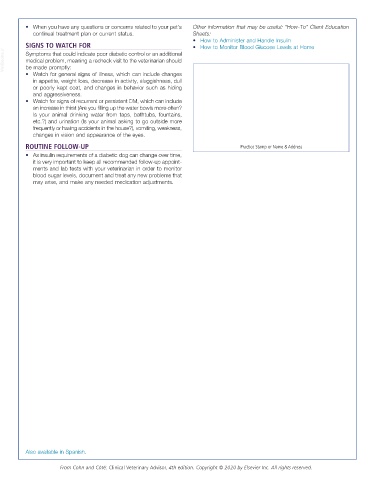Page 2981 - Cote clinical veterinary advisor dogs and cats 4th
P. 2981
• When you have any questions or concerns related to your pet’s Other information that may be useful: “How-To” Client Education
continual treatment plan or current status. Sheets:
• How to Administer and Handle Insulin
SIGNS TO WATCH FOR • How to Monitor Blood Glucose Levels at Home
VetBooks.ir Symptoms that could indicate poor diabetic control or an additional
medical problem, meaning a recheck visit to the veterinarian should
be made promptly:
• Watch for general signs of illness, which can include changes
in appetite, weight loss, decrease in activity, sluggishness, dull
or poorly kept coat, and changes in behavior such as hiding
and aggressiveness.
• Watch for signs of recurrent or persistent DM, which can include
an increase in thirst (Are you filling up the water bowls more often?
Is your animal drinking water from taps, bathtubs, fountains,
etc.?) and urination (Is your animal asking to go outside more
frequently or having accidents in the house?), vomiting, weakness,
changes in vision and appearance of the eyes.
ROUTINE FOLLOW-UP Practice Stamp or Name & Address
• As insulin requirements of a diabetic dog can change over time,
it is very important to keep all recommended follow-up appoint-
ments and lab tests with your veterinarian in order to monitor
blood sugar levels, document and treat any new problems that
may arise, and make any needed medication adjustments.
Also available in Spanish.
From Cohn and Côté: Clinical Veterinary Advisor, 4th edition. Copyright © 2020 by Elsevier Inc. All rights reserved.

